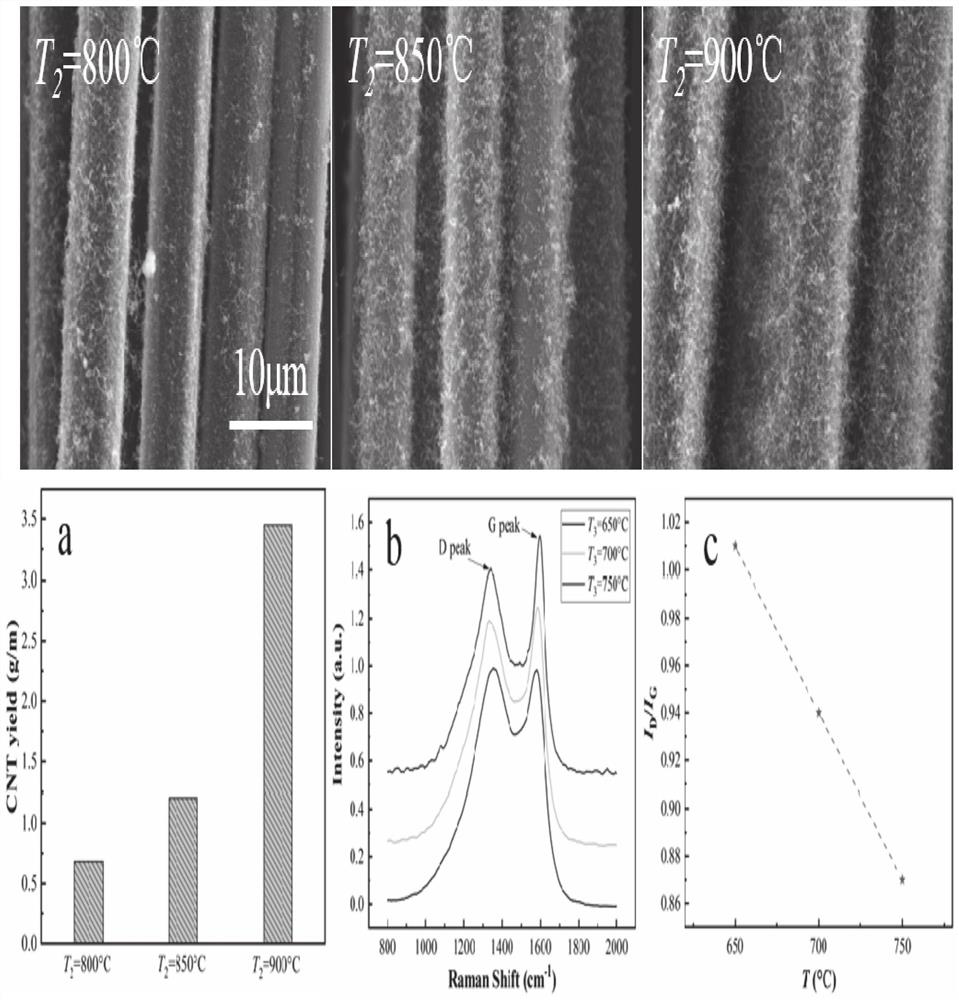Device and method for controlling growth state of carbon nano tubes based on decoupling heat treatment and application thereof
A technology of carbon nanotubes, growth state, applied in chemical instruments and methods, carbon compounds, inorganic chemistry, etc., can solve problems such as limitations
- Summary
- Abstract
- Description
- Claims
- Application Information
AI Technical Summary
Problems solved by technology
Method used
Image
Examples
Embodiment 1
[0066] Step 1: Purging the experimental reactor with inert gas and maintaining an inert environment to eliminate the interference of the air environment on the experiment.
[0067] Step 2: After the carbon fiber is modified by electrochemical anodization, the carbon fiber is immersed in 0.05mol / L Co(NO 3 ) 2 Load the catalyst precursor in the ethanol solution for 10 minutes;
[0068] Step 3: Put the carbon fiber obtained in step 2 into the catalyst reduction unit of the reactor, under an inert gas atmosphere, use H 2 Reducing the catalyst precursor coating to metal nanoparticles, the reduction temperature is 400°C, and the reduction time is 15 minutes;
[0069] Step 4: Continue to extend the carbon fiber sample obtained in step 3 into the reactor, pass in the reaction gas, decompose in the carbon source decomposition unit at 800°C for 5 minutes, and then enter the carbon nanotube growth unit to synthesize carbon nanotubes at 650°C , and finally collect the samples.
[0070...
Embodiment 2
[0072] Step 1: Purging the experimental reactor with inert gas and maintaining an inert environment to eliminate the interference of the air environment on the experiment.
[0073] Step 2: After the carbon fiber is modified by electrochemical anodization, the carbon fiber is immersed in 0.05mol / L Co(NO 3 ) 2 Load the catalyst precursor in the ethanol solution for 10 minutes;
[0074] Step 3: Put the carbon fiber obtained in step 2 into the catalyst reduction unit of the reactor, under an inert gas atmosphere, use H 2 The catalyst precursor coating was reduced to metal nanoparticles, the reduction temperature was 450°C, and the reduction time was 15 minutes;
[0075] Step 4: Continue to extend the carbon fiber sample obtained in step 3 into the reactor, pass in the reaction gas, decompose in the carbon source decomposition unit at 800°C for 5 minutes, and then enter the carbon nanotube growth unit to synthesize carbon nanotubes at 650°C , and finally collect the samples.
...
Embodiment 3
[0078] Step 1: Purging the experimental reactor with inert gas and maintaining an inert environment to eliminate the interference of the air environment on the experiment.
[0079] Step 2: After the carbon fiber is modified by electrochemical anodization, the carbon fiber is immersed in 0.05mol / L Co(NO 3 ) 2 Load the catalyst precursor in the ethanol solution for 10 minutes;
[0080] Step 3: Put the carbon fiber obtained in step 2 into the catalyst reduction unit of the reactor, under an inert gas atmosphere, use H 2Reducing the catalyst precursor coating to metal nanoparticles, the reduction temperature is 500°C, and the reduction time is 15 minutes;
[0081] Step 4: Continue to extend the carbon fiber sample obtained in step 3 into the reactor, pass in the reaction gas, decompose in the carbon source decomposition unit at 800°C for 5 minutes, and then enter the carbon nanotube growth unit to synthesize carbon nanotubes at 650°C , and finally collect the samples.
[0082]...
PUM
| Property | Measurement | Unit |
|---|---|---|
| diameter | aaaaa | aaaaa |
| diameter | aaaaa | aaaaa |
| diameter | aaaaa | aaaaa |
Abstract
Description
Claims
Application Information
 Login to View More
Login to View More - R&D
- Intellectual Property
- Life Sciences
- Materials
- Tech Scout
- Unparalleled Data Quality
- Higher Quality Content
- 60% Fewer Hallucinations
Browse by: Latest US Patents, China's latest patents, Technical Efficacy Thesaurus, Application Domain, Technology Topic, Popular Technical Reports.
© 2025 PatSnap. All rights reserved.Legal|Privacy policy|Modern Slavery Act Transparency Statement|Sitemap|About US| Contact US: help@patsnap.com



